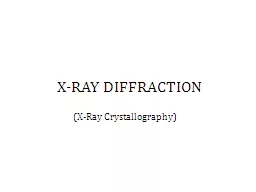

XRay Diffraction I XRay Diffraction Uses XRays to identify the arrangement of atoms molecules or ions within a crystalline solid Quantitative and qualitative Ooi L Principles of Xray Crystallography ID: 253285
Download Presentation The PPT/PDF document "(X-Ray Crystallography)" is the property of its rightful owner. Permission is granted to download and print the materials on this web site for personal, non-commercial use only, and to display it on your personal computer provided you do not modify the materials and that you retain all copyright notices contained in the materials. By downloading content from our website, you accept the terms of this agreement.
Slide1
(X-Ray Crystallography)
X-Ray DiffractionSlide2
I. X-Ray Diffraction
Uses X-Rays to identify the arrangement of atoms, molecules, or ions within a crystalline solid
Quantitative and qualitative
Ooi
, L.
Principles of X-ray Crystallography
(2010)Slide3
A. X-Rays
0.1 – 100 Angstroms (
Å)Useful Range: 0.5 – 2.5 ÅSlide4
B. Amorphous Substances
1. Gases and Liquids
Extremely difficult
2. Non-crystalline Solids
Atoms are not regularly arranged or regularly shapedInterferenceFiber DiffractionSlide5
Atoms
are
regularly arranged
“The Unit Cell” – a cookie cutter
C
.
Crystalline Solids
Rhodes, G.
Crystallography Made Crystal Clear, 3
rd
ed.
(2006)Slide6
II. X-Ray C
rystallography
A. Small-molecule crystallography
Up to ~100 atomsOrganic molecules, catalysts, newly synthesized drugs, etc.
Identify each atomB. Macromolecular (protein) crystallography Large biological molecules – nucleic acids and proteinsIdentify 2° structureNote: must show that the crystal structure (asymmetric unit) is comparable to structure in solution (biological unit) Slide7
III. X-Ray
Diffractometer
Ooi
, L. Principles of X-ray Crystallography
(2010)Slide8
A. X-Ray Source
Rhodes, G.
Crystallography Made Crystal Clear, 3
rd ed. (2006)
1. X-Ray Tube (a)2. Rotating Anode (b) Slide9
3. Particle Storage Ring (Synchrotron Radiation)
Particle Accelerator
Ooi
, L.
Principles of X-ray Crystallography
(2010)Slide10
Rhodes, G.
Crystallography Made Crystal Clear, 3
rd
ed.
(2006)
National Synchrotron Light Source at Brookhaven National Lab (Long Island)
Slide11
B. Collimator
Narrow metal tube that selects and reflects the X-Rays into parallel paths
Ooi, L. Principles of X-ray Crystallography (2010)Slide12
C. Crystal (Sample)
Rhodes, G.
Crystallography Made Crystal Clear, 3
rd ed. (2006)
1. Growth – Screens Crystal vs. useless blob2. OptimizationQuantity3. Crystal QualityPurity
4. Mount for Data Collection
Cryocrystallography
Note:
Diffracted in “mother liquor”Slide13
D. Camera
Rhodes, G.
Crystallography Made Crystal Clear, 3
rd ed. (2006)
Goniometer
Goniostat
Slide14
Rhodes, G.
Crystallography Made Crystal Clear, 3
rd
ed.
(2006)Slide15
E. Detector
Rhodes, G.
Crystallography Made Crystal Clear, 3
rd ed. (2006)
1. Charged Couple Device (CCD)2. Image Plate (IP) Slide16
IV. Data Analysis
Measure intensity and position of diffracted
X-Rays
Intensity: strength of diffracted beamPosition:
direction in which beam was diffracted by the crystal
Rhodes, G.
Crystallography Made Crystal Clear, 3
rd
ed.
(2006)Slide17
Ooi
, L.
Principles of X-ray Crystallography
(2010)
Computer calculates this data from the diffraction
patternSlide18
A. Fournier Sum
Based on simple waves
f(x) = F
cos 2π
(hx + α)
F = f
0
+ f
1
+ f
2
+ …Rhodes, G. Crystallography Made Crystal Clear, 3rd ed. (2006)Slide19
B. Bragg’s Law
States: diffraction spots occur when 2
d sin θ = n
λ
Rhodes, G.
Crystallography Made Crystal Clear, 3
rd
ed.
(2006)Slide20Slide21Slide22
Molecular structure in solid crystalline state with extreme certainty
Direct inference of data
Provides limitless info.
CrystalsSlow
HydrogenStill just a modelBenefits
Downfalls